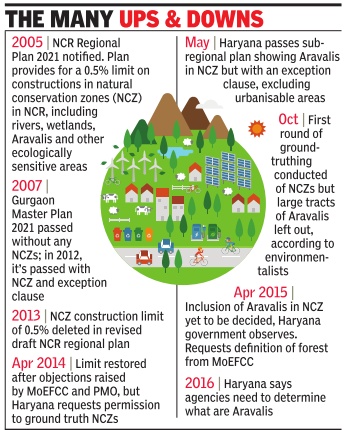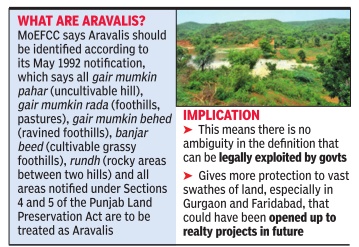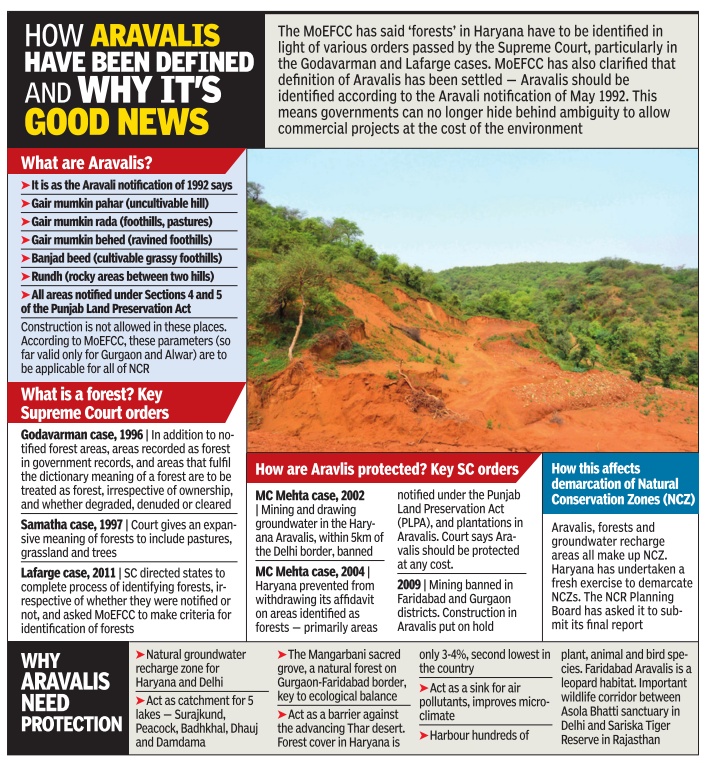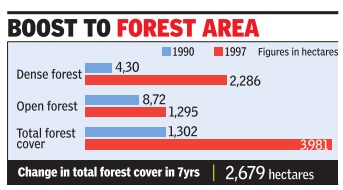Aravali range
(→Conservation mechanisms) |
(→Conservation mechanisms) |
||
| Line 191: | Line 191: | ||
“The Board also clarified the position regarding demarcation of Aravalli range and delineation of NCZ. It said that the notification issued by the Ministry of Environment and Forests in 1992 has clearly explained for districts of Gurgaon in Haryana and Alwar in Rajasthan for regulating certain processes and operations in specified areas of Aravali range and this notification would guide identification and delineation of Aravalis in the entire NCR,“ an official statement from urban development ministry said. | “The Board also clarified the position regarding demarcation of Aravalli range and delineation of NCZ. It said that the notification issued by the Ministry of Environment and Forests in 1992 has clearly explained for districts of Gurgaon in Haryana and Alwar in Rajasthan for regulating certain processes and operations in specified areas of Aravali range and this notification would guide identification and delineation of Aravalis in the entire NCR,“ an official statement from urban development ministry said. | ||
| − | Minister of state for urban development Rao Inderjit Singh said the curbs on construction in Aravalis and water recharge zones is essential for “sustainable development“ of the NCR. “It becomes our responsibility to protect this area for future generation,“ he told | + | Minister of state for urban development Rao Inderjit Singh said the curbs on construction in Aravalis and water recharge zones is essential for “sustainable development“ of the NCR. “It becomes our responsibility to protect this area for future generation,“ he told. |
| + | |||
| + | =Damage= | ||
| + | [https://www.thehindu.com/news/national/damage-to-aravallis-scary/article24929009.ece Krishnadas Rajagopal, SC orders demolition of illegal structures, September 11, 2018: ''The Hindu''] | ||
| + | |||
| + | ''' ‘Damage to Aravallis scary’ ''' | ||
| + | |||
| + | The Supreme Court on Tuesday ordered the demolition of structures built illegally by a prominent builder in the protected forests of the Aravallis, noting that ecological damage done by colonisers to the ancient hills was irreversible and “quite frightening.” | ||
| + | |||
| + | A Bench of Justices Madan B. Lokur and Deepak Gupta ordered that all structures built after August 18, 1992 in the area known as ‘Kant Enclave’ at Anangpur in Faridabad district of Haryana should be demolished. | ||
| + | |||
| + | They have to be razed down by December 31, 2018, the court said. | ||
| + | |||
| + | It held that these illegal structures defy a Haryana government notification of August 18, 1992, issued under the Punjab Land Preservation Act, declaring the area as forest land and fragile. | ||
| + | |||
| + | |||
| + | '''Granted exemption''' | ||
| + | |||
| + | The court, however, ordered not to disturb constructions made between April 17, 1984 and August 18, 1992. These structures were built on the basis of an exemption given to Kant &Co by the State’s town planning department under the Haryana Development and Regulation of Urban Areas Act of 1975 for setting up a “film studio and allied complex” in the area. The exemption was removed when the August 18, 1992 notification kicked in. | ||
| + | |||
| + | Kant & Co, the court ordered, should pay a full refund to investors to whom they had already transferred the land. The builder has to pay interest at 18% per annum from the date of the investment. | ||
| + | |||
| + | |||
| + | '''Dept. pulled up''' | ||
| + | |||
| + | The court pulled up the State town and country planning department for supporting the illegalities. The department was myopic and brazen to push its agenda in favour of the builder no matter what it cost to the environment and ground water in the area. | ||
| + | |||
| + | The Bench accused the department of having “completely vitiated the efforts of the forest department as well as the orders of the Supreme Court.” | ||
| + | |||
| + | “There is no doubt that at the end of the day, the State of Haryana comes out in very poor light and must be held accountable for its conflicting and self-destructive stand,” Justice Lokur, who wrote the 81-page judgment, observed. | ||
| + | |||
| + | “It is not only the future generations that have to pay a heavy price for this environmental degradation, but even the present generation is paying a heavy price for the environmental and ecological degradation inasmuch as there is an acute water shortage in the area as prophesied by the Central Ground Water Board,” he said. | ||
=Desertification= | =Desertification= | ||
Revision as of 08:52, 12 September 2018
This is a collection of articles archived for the excellence of their content. Readers will be able to edit existing articles and post new articles directly |
Contents |
What are the Aravalis?
The 1992 definition
See graphics:
What are Aravalis-I
What are the Aravalis- II
Master Plan 2021 Defines Conservation Zones, Removes Ambiguity In Definition & Scope
The definition of Aravalis, whose definition of Aravalis, whose ambiguous interpretation has for years led to many court battles for the protection of the ecologically fragile hill ranges, has been decided by the Centre.
Removing all grey areas, which have been consistently exploited to give Aravali land away to real estate, particularly in Haryana, the Union environment ministry (MoEFCC) has told the National Green Tribunal that the Aravalis across NCR can be defined through their May 1992 notification.
Known as the `Aravali notification', it says apart from reserved forests or places already classified as `forest' in government records, areas categorised as gair mumkin pahar (uncultivable hill), gair mumkin rada (foothills, pastures), gair mumkin be hed (ravined foothills), banjar beed (cultivable grassy foothills) and rundh (rocky areas between two hills) will be treated as Aravalis.
The same status is also to be given now to any land classified under sections 4 and 5 of the Punjab Land Preservation Act. All such areas in NCR will be protected and identified as Aravalis, the MoEFCC has told the green court.
The immediate implication of this is that it extends a protective cover to large swathes of land in NCR, especially in Gurgaon and Faridabad, and will strengthen the case of environmentalists fighting court battles. The submission by the Union environment ministry (MoEFCC) -made during a hearing into a recent tree-felling case in Faridabad where Aravali land was allotted to a real estate company -is also significant because the Haryana government has been claiming the status of such land has not yet been decided, leaving them open to real estate projects. Before this, the Aravali notification was applicable only to Gurgaon and Alwar (Rajasthan).
The affidavit in NGT also removes ambiguity around natural conservation zones (NCZ) -the other major area of environmental concern in NCR -stating NCZs have been clearly defined in the Regional Plan 2021 of the National Capital Region Planning Board (NCRPB). The affidavit states: “components of NCZ, including `forest,' `Aravali' and `groundwater recharging areas' are to be governed by various statutes, rules and notifications of the MoEFCC, other central government departments or ministries, orders of SC (Supreme Court) and high courts and MoEFCC's notification dated May 7, 1992“.
“Therefore, the issue related to definition has been adequately addressed. The NCR state governments have to accordingly delineate the NCZ...“ the affidavit states.Since NCZs incorporate the Aravalis, it would mean states such as Haryana have to define the Aravalis as well.
Another grey area in Haryana is the definition of `forest', which too has been exploited, and the MoEFCC affidavit throws light on that as well. It says `forest' in Haryana will have to be identified by the state in accordance with the Supreme Court judgment dated December 12, 1996 in the TN Godavarman case and that the exercise of identifying forests and preparation of geo-referenced maps has to be done by in line with the Supreme Court judgment of July 6, 2011in the Lafarge Uranium Mining Ltd case.
The Aravali hills of Haryana in Faridabad, Gurgaon and other districts are covered with forests that var y from pristine, like Mangarbani, to degraded scrub. Environmental analyst Chetan Agarwal explained, “The Godavarman judgment broadly said all forests would receive the protection of the Forest Conservation Act, irrespective of ownership, and classi fication, and their condition.The implication of this judgment is that for the purpose of the Forest Conservation Act of 1980, `forests' would include all statutory recognised forests, whether designated as reserved, protected or otherwise, those marked so in revenue records, and all areas, recorded or not, which fulfil the dictionary meaning of a `forest'. Therefore, virtually the entire Haryana Aravalis fulfil the dictionary meaning of `forest'.“
The MoEFCC said the decisions on the definition and demarcation of Aravalis were taken in a meeting of the NCR Planning Board headed by former urban development minister Venkaiah Naidu last December.In a separate affidavit to the NGT, the NCR Planning Board said the Haryana government is required to ascertain the status of NCZs. The Haryana government, which has over the years made several attempts to dilute the definition of NCZs, has started an exercise to redraw these natural conservation zones but hasn't completed it. “The Haryana government has to submit the final report along with maps on the NCZ delineation exercise,“ says the NCR Planning Board's affidavit.
The background to this case is that a real estate company had approached the Faridabad divisional forest officer, seeking permission to fell trees on a 52-acre plot it had acquired for a group housing society project in Sarai Khwaja, a village in Faridabad. Sarai Khwaja is recorded as gair mumkin pahar, which is protected under the Aravali notification. Between September and November 2015, the Faridabad forest officials had rejected approval for felling these trees because gair mumkin pahar's conservation status was “yet to be decided“.Thereafter, ignoring the opinion of the forest department, which had denied permission for tree-felling, Haryana's additional chief secretary issued a letter on April 24, 2017, directing the department to grant the developer approval for felling trees.
A senior forest official, who did not wish to be named, said NCZs should have been decided by the forest department but Haryana had given the job to the department of town and country planning, an agency that dealt with realtors. “The forest department has limited role in deciding NCZs,“ said the official.
Haryana’s point of view/ 2017
Jayashree Nandi, December 4, 2017: The Times of India
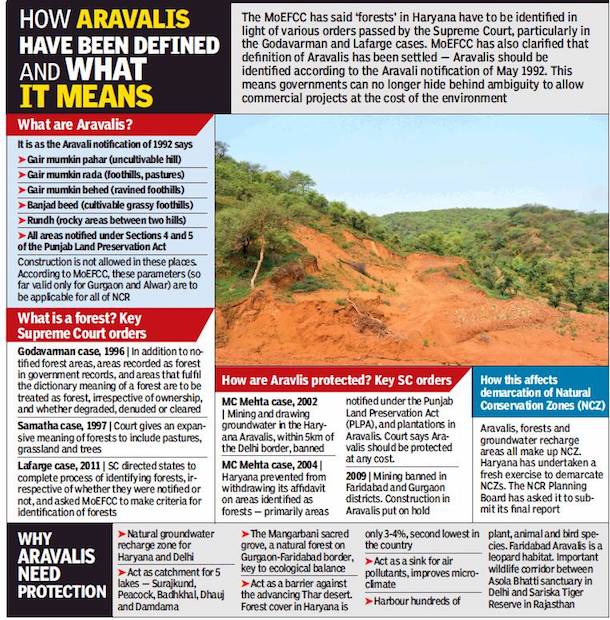
ii) Supreme Court orders, 1996;
iii) MC Mehta’s cases of 2002 and 2004;
iv) Why the Aravalis need protection
From: Jayashree Nandi, December 4, 2017: The Times of India
See graphic:
i) The 1992 definition of the Aravalis; ii) Supreme Court orders, 1996; iii) MC Mehta’s cases of 2002 and 2004; iv) Why the Aravalis need protection
The Haryana government is likely to submit its final view on what consists Aravalis in the state at the 37th meeting of the National Capital Region Planning Board (NCRPB) to be held on Monday. The agenda notes of the meeting accessed by TOI state that the Haryana government seeks to limit ‘Aravalis’ to only the stretches in Gurgaon. This leaves out large parts of the Aravalis in Faridabad (over 17,000 acres) and other districts from any kind of protective regulation.
The Haryana government has informed the NCRPB that it will consider only those areas to be part of the Aravali range that are mentioned in the Aravali notification of 1992 issued by the environment ministry and not recognise any additional areas to be Aravalis. The 1992 notification is applicable only to Gurgaon in Haryana and Alwar district in Rajasthan.
Why 17k acres of Aravali may be left out of protective cover
The agenda notes recount that the Haryana government is against any cap on construction activities in the natural conservation zones (NCZs) as defined in the draft regional plan 2021. The plan includes Aravalis in NCZs where construction is not allowed beyond 0.5% of the area. The Haryana government had, however, stated in the NCRPB’s special meeting in December 2016 that the 1992 notification allowed for construction of roads and buildings even in the Aravali areas with permission from the Union environment ministry. So, Haryana will not consider any additional cap on construction specified in the draft regional plan of NCRPB.
Further, in a letter dated June 15, 2017, the Haryana principal secretary (town and country planning department) has informed the ministry of urban development that it will consider only those areas to be Aravalis that are appended in the 1992 notification table. “Therefore, for any area of Haryana to be considered as being part of NCZ by virtue of being Aravalis, it must necessarily be a part of the said table,” the letter said.
The agenda notes said that NCRPB had written to the Haryana government to clarify their stand recently. “It appears that the above decision (limiting Aravalis to Gurgaon) has been taken without taking into consideration the decisions of the board taken in its special meeting held on December 20, 2016 w.r.t. identification or delineation of ‘Aravalli’. This is also against Govt of Haryana’s earlier confirmation in this regard given in the said Special Meeting of the Board. Accordingly, it is requested to reconsider the decision in the matter.”
In letters submitted to the National Green Tribunal (NGT) in July 2017, the Haryana government had claimed that “certain pockets recorded as gair mumkin pahar (uncultivable hill)” cannot be categorised as Aravalis as they are already being used for agriculture, roads, buildings and other such projects. A letter dated January 19, 2017, from Haryana CM Manohar Lal Khattar to Venkaiah Naidu, the then Union urban development minister, was also submitted in NGT along with an affidavit from the town and country planning department, which states that the Haryana government will enforce the ‘Aravali notification’ of 1992, which is only applicable to the Aravalis in Gurgaon and Alwar in Rajasthan.
But the Union environment ministry (MoEFCC) had told NGT that the Aravalis across NCR can be defined through the revenue record ‘terms’ listed in their May 1992 notification. Apart from reserved forests or places already classified as ‘forest’ in government records, areas categorised as gair mumkin pahar (uncultivable hill), gair mumkin rada (foothills, pastures), gair mumkin be hed (ravined foothills), banjar beed (cultivable grassy foothills) and rundh (rocky areas between two hills) in entire NCR will be treated as Aravalis.
The planning committee of NCRPB had also decided that the Aravalis in entire NCR be delineated based on the 1992 notification. “Therefore, Govt.of Haryana should expedite the exercise of NCZ delineation and submit the final report to the environment ministry, in compliance to the decision of the 35th board meeting,” the agenda notes state. But the Haryana government has still not started the process of delineation leaving ecologically sensitive areas vulnerable to real estate and other projects.
Earlier in May, 2015, the state had given an assurance in the board meeting of the NCRPB that it would maintain status quo on 50,000 acres of primarily Aravali areas, whose legal forest status was yet to be determined. However on May 12017, the government had withdrawn the forest status to be decided tag – stating there are no such areas in the state. This has left even the Mangar Bani sacred grove without a forest tag.
Conservation mechanisms
Steps taken, state-wise
Haryana, 2016: protection of "potential" wildlife areas
The Times of India, Feb 05 2016
Wildlife study to find focus spots
Jayashree Nandi
A study by the Wildlife Institute of India (WII) will soon point out “potential“ wildlife areas in the Aravalis in Haryana that require special conservation measures and protection from urbanisation. The Haryana forest department had commissioned WII to carry out a survey to identify vulnerable areas that needed government intervention.
The Aravali range ends in Haryana and is, therefore, an ecologically fragile region that is threatened by modernity . Unlike in Rajasthan, which has a number of protected areas, including the Sariska National Park, the wildlife-rich areas of Haryana had never been identified. “The forest department wants to have a document at hand to be able to resist any pressure to change land use,“ said Bilal Habib of the animal ecology and conservation biology department at WII.
The WII team comprising project biologists Anchal Bhasin and Paridhi Jain, along with local villagers, have finished scouting a 30-km area around Damdama lake, Sultanpur Bird Sanctuary and parts of Mewat in the past month or so.They found ample evidence of wildlife, particularly around Damdama lake, including a 2.5-km-long trail of leopard pugmarks. They also noticed hyena pugmarks and some unidentified pugmarks that could be of the Indian fox.
Despite the presence of tigers in the Rajasthan Aravalis, the WII team isn't quite hopeful of finding the big cats on the Haryana side because the habitat is quite degraded. “There is too much human presence and disturbance for tigers to be living here. Tigers also don't prefer undulating terrain as habitats,“ explained Bhasin.She said that if it could be confirmed that the Indian fox could indeed be found here, it would be an important discovery .Indicators of leopard presence are, of course, the most important discovery because it means there are many other smal ler animals living there on which the spotted cats prey .
Natural Conservation Zone
The Times of India, April 7, 2016
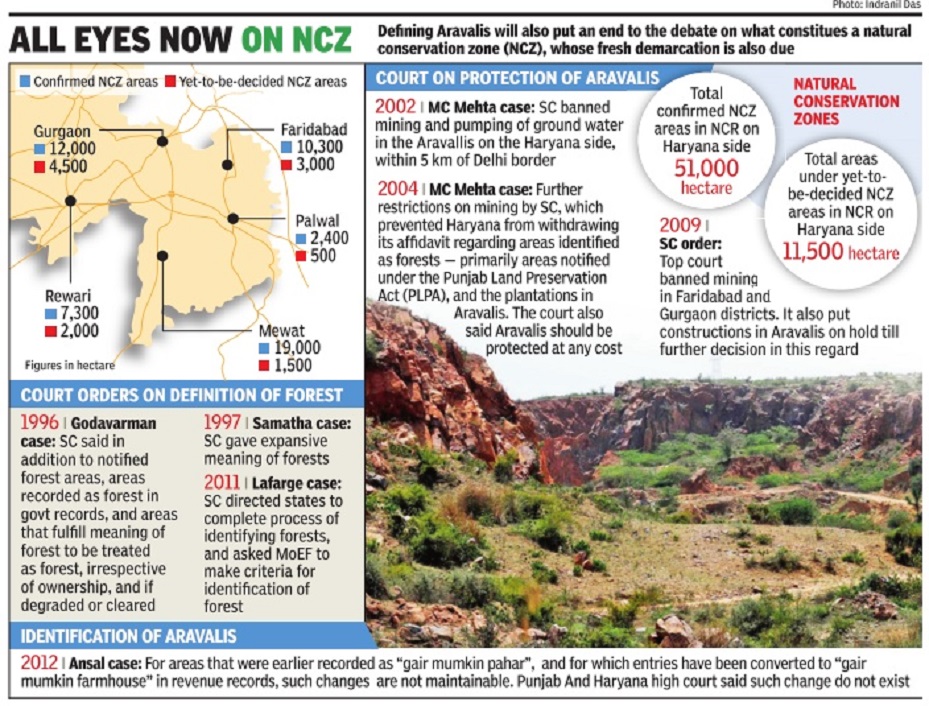
The Times of India
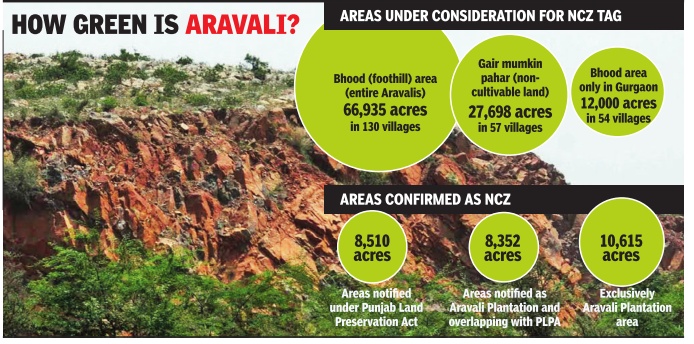
Bagish Jha
NCR May Lose Major Water Recharge Zones Due To Land-Use Change
Over 90% of foothills out of NCZ?
Large tracts of land in Aravali foothills are likely to remain out of the proposed natural conservation zone (NCZ), mainly due to change in land use of these areas in the past decades. Out of the 1,200 acres of bhood (a revenue term for foothills of Aravalis) in Gurgaon, only 80 acres are expected to be incorporated in NCZ, as land use of the rest of the land has been changed, purportedly to avoid classification as forest land that makes its use for any commercial project impossible.
An exercise for a fresh and scientific demarcation of NCZs has been on for months and a committee overseeing it is expected to submit its final proposal by April 13.
According to environmentalists, bhood areas are important water recharge zones and their conservation is important for recharging the groundwater of the entire NCR. They fear exclusion of bhood areas from NCZ will have a serious implication on the ecological balance of the region.
A government source said ownership of most of the land that may be excluded from the demarcation exercise, lies indirectly with realtors. “Developers are waiting for the NCZ notification to go ahead with their plan to build residential complexes in these area after changing land use from agricultural,“ the source said.
Additional chief secretary , department of town and country planning, P Raghvendra Rao said on Wednesday a final decision had not been taken yet and only discussions on definitions of certain revenue terms and how to assess areas under NCZ had taken place.“The district-level committee will finalise things and submit the proposal for demarcation of NCZ. There are differences of opinion on certain issues.We will look into them once the proposal was submitted by the district-level committee,“ said Rao.
He added, “We have an open mind and we are very concerned about environment and water recharge zones. So, if some issues were raised by anyone, we will consider them.“ He said NCZ areas had almost been finalised in Haryana's NCR districts except in some parts of Gurgaon and Mewat.
Forest officials have objected to exclusion of foothills from NCZ. “Land use was changes only on paper. Large tracts are still as they were decades back. These areas should be included in NCZ,“ said a senior forest official. A forest official clarified that areas like bhood, wasteland and paleochannels (streams that once existed but don't any more) are not notified as forest, so they can only suggest their inclusion.
“Nearly 11,910 hectares of land in Gurgaon is confirmed under NCZ and a large tract of land is under `yet to be decided' NCZ,“ Gurgaon deputy commissioner T L Satyaprakash said. Large parts of the land in the `yet to be decided' category are owned by private individuals and some of it under litigation, he added.
According to Satyaprakash, several years back, nearly 1,200 acres of land in Gurgaon was under bhood. “Over a period, land use changed and today most of this land is irrigated agriculture land in government records. Now, only 80 acres of this land remains as bhood,“ said Satyaprakash, He added that it would be difficult to include 1,200 acre of bhood under NCZ.
Similarly , wasteland and palaeochannel are not record ed in revenue records. “So we are not able to identify them.So, incorporating them in NCZ would be difficult,“ he said.
Originally, only land notified as forest, Aravali Plantation and land protected under Sections 4 & 5 of Punjab and Haryana Land Protection Act, 1990, water bodies and some other areas were to be identified as Natural Conservation Zone. “Later, on the request of government departments and some people, more areas were incorporated,“ said Satyaprakash. “The land use was changed illegally . Excluding areas under foothills will lead to destruction of Aravali and it will defeat the entire purpose of demarcating NCZ,“ said environmentalist Col SS Oberai.
December 2016: Sanction by NCR Planning Board
The Times of India, Dec 21 2016
Dipak Dash
NCRPB Decision Paves Way For Conservation Of Range
NCR Planning Board (NCRPB) put its stamp on bringing all noncultivable hill land, rocky and sandy areas in the ecologically sensitive Aravalis across NCR within the ambit of the mountain range. This decision paves the way for protection and conservation of Aravalis, which has been on the radar of real estate developers. No non-forest activity is allowed in Aravalis without prior permission of environment and forest ministry , meaning there will be hardly any scope for real estate or other construction work in such areas.
The decision was taken at the board meeting chaired by urban development minister M Venkaiah Naidu and attended by Haryana chief minister Manohar Lal Khattar besides representatives from Delhi and Rajasthan government.
However, what stumped many in the meeting was a request by a top Haryana government official reiterating the demand to remove restrictions on construction in Natural Conservation Zone (NCZ), which covers entire Aravali, lakes and water recharge zones. The Regional Plan of NCR, which has the consent of Haryana government, clearly treats the entire Aravalis as NCZ where construction is not allowed beyond 0.5% of the area.
The senior Haryana offici al raising the issue of doing away with this cap on construction shows how state bureaucracy is sticking to its demand of more construction in the ecologically fragile zone despite change of government. The earlier Bhupinder Singh Hooda government had unsuccessfully pushed for a similar course of action. Sources said Haryana officials want that allowing any construction activities in NCZ should be subject to approval from the environment ministry rather than having any overall limit on construction in such areas.
“The Board also clarified the position regarding demarcation of Aravalli range and delineation of NCZ. It said that the notification issued by the Ministry of Environment and Forests in 1992 has clearly explained for districts of Gurgaon in Haryana and Alwar in Rajasthan for regulating certain processes and operations in specified areas of Aravali range and this notification would guide identification and delineation of Aravalis in the entire NCR,“ an official statement from urban development ministry said.
Minister of state for urban development Rao Inderjit Singh said the curbs on construction in Aravalis and water recharge zones is essential for “sustainable development“ of the NCR. “It becomes our responsibility to protect this area for future generation,“ he told
Nature Education and Cure Centre
The Times of India, Demcember 13, 2016
Dipak Dash
In a controversial move, the Haryana forest department has proposed to issue a “corrigendum“ to de-notify 85 acres of forest land in the Aravalis in Gurugram where a `Nature Education and Cure Centre' will be set up in publicprivate partnership mode.
The land, along with another 500 acres, was repossessed by Haryana government in 2001 from Bharat Yatra Kendra, which included the “farm house“ of former PM Chandrasekhar, after his demise. The possession was transferred following a Supreme Court order. While 500 acres went back to the forest department, 85 acres, with nearly 20 structures, was restored to the gram panchayat.
The gram panchayat gave the 85 acres to the forest de partment to manage it, under section 38 of Forest Conservation Act. The entire 585 acres was notified as forest in 2004.The forest department later gave the land to Haryana Forest Development Corporation.
“Issuing corrigendum is an afterthought or a bureaucratic ploy to mislead political bosses to de-notify any forest land. This will open the floodgates for misuse, as both government agencies and private players are eyeing Aravalis for commercial exploitation,“ said R P Balwan, former conservator of forests.
He added there were efforts to use protected forest in Shivalik hill in the state for raising medicinal plants.“Under FCA, you cannot denotify a forest area and these cannot be used for commercial purpose. How can HFDC, which is only caretaker on behalf of forest department, moot a proposal to roll out a PPP project, which is nothing more than providing an entry to private players in forest area?“ Balwan said.
2016: All non-forest activity banned
Dipak Dash, All land near Aravalis now protected, Dec 21, 2016: The Times of India
NCRPB Decision Paves Way For Conservation Of Range
NCR Planning Board (NCRPB) put its stamp on bringing all noncultivable hill land, rocky and sandy areas in the ecologically sensitive Aravalis across NCR within the ambit of the mountain range. This decision paves the way for protection and conservation of Aravalis, which has been on the radar of real estate developers.
No non-forest activity is allowed in Aravalis without prior permission of environment and forest ministry , meaning there will be hardly any scope for real estate or other construction work in such areas.
The decision was taken at the board meeting chaired by urban development minister M Venkaiah Naidu and attended by Haryana chief minister Manohar Lal Khattar besides representatives from Delhi and Rajasthan government.
However, what stumped many in the meeting was a request by a top Haryana government official reiterating the demand to remove restrictions on construction in Natural Conservation Zone (NCZ), which covers entire Aravali, lakes and water recharge zones. The Regional Plan of NCR, which has the consent of Haryana government, clearly treats the entire Aravalis as NCZ where construction is not allowed beyond 0.5% of the area.
The senior Haryana offici al raising the issue of doing away with this cap on construction shows how state bureaucracy is sticking to its demand of more construction in the ecologically fragile zone despite change of government. The earlier Bhupinder Singh Hooda government had unsuccessfully pushed for a similar course of action. Sources said Haryana officials want that allowing any construction activities in NCZ should be subject to approval from the environment ministry rather than having any overall limit on construction in such areas.
“The Board also clarified the position regarding demarcation of Aravalli range and delineation of NCZ. It said that the notification issued by the Ministry of Environment and Forests in 1992 has clearly explained for districts of Gurgaon in Haryana and Alwar in Rajasthan for regulating certain processes and operations in specified areas of Aravali range and this notification would guide identification and delineation of Aravalis in the entire NCR,“ an official statement from urban development ministry said.
Minister of state for urban development Rao Inderjit Singh said the curbs on construction in Aravalis and water recharge zones is essential for “sustainable development“ of the NCR. “It becomes our responsibility to protect this area for future generation,“ he told.
Damage
Krishnadas Rajagopal, SC orders demolition of illegal structures, September 11, 2018: The Hindu
‘Damage to Aravallis scary’
The Supreme Court on Tuesday ordered the demolition of structures built illegally by a prominent builder in the protected forests of the Aravallis, noting that ecological damage done by colonisers to the ancient hills was irreversible and “quite frightening.”
A Bench of Justices Madan B. Lokur and Deepak Gupta ordered that all structures built after August 18, 1992 in the area known as ‘Kant Enclave’ at Anangpur in Faridabad district of Haryana should be demolished.
They have to be razed down by December 31, 2018, the court said.
It held that these illegal structures defy a Haryana government notification of August 18, 1992, issued under the Punjab Land Preservation Act, declaring the area as forest land and fragile.
Granted exemption
The court, however, ordered not to disturb constructions made between April 17, 1984 and August 18, 1992. These structures were built on the basis of an exemption given to Kant &Co by the State’s town planning department under the Haryana Development and Regulation of Urban Areas Act of 1975 for setting up a “film studio and allied complex” in the area. The exemption was removed when the August 18, 1992 notification kicked in.
Kant & Co, the court ordered, should pay a full refund to investors to whom they had already transferred the land. The builder has to pay interest at 18% per annum from the date of the investment.
Dept. pulled up
The court pulled up the State town and country planning department for supporting the illegalities. The department was myopic and brazen to push its agenda in favour of the builder no matter what it cost to the environment and ground water in the area.
The Bench accused the department of having “completely vitiated the efforts of the forest department as well as the orders of the Supreme Court.”
“There is no doubt that at the end of the day, the State of Haryana comes out in very poor light and must be held accountable for its conflicting and self-destructive stand,” Justice Lokur, who wrote the 81-page judgment, observed.
“It is not only the future generations that have to pay a heavy price for this environmental degradation, but even the present generation is paying a heavy price for the environmental and ecological degradation inasmuch as there is an acute water shortage in the area as prophesied by the Central Ground Water Board,” he said.
Desertification
Aravalis are losing power to check desert spread
Natural Forests Are Shrinking In Areas That Are Holding Up The Ecosystem
The threat of desertification, which has loomed for decades over the exploited Aravali ranges, is growing, and its most palpable manifestation is in naturally forested sections that have started to lose their vegetation, particularly in Haryana, a study has said.
As a result, the hills are losing their capability of acting as an effective green barrier to the expansion of the Thar desert towards southern Haryana and Delhi. The study, conducted by researchers at the Wildlife Institute of India (WII), points out a dozen gap areas — forested areas that fill intervals in the rocky ranges — in Haryana and Rajasthan whose green cover has declined.
Green cover, increase/ decrease in
400% increase in 1990s, decline after 2000
Report Claims Plantation Drives Were Shot In Arm For 7 Districts
The state forest department on Monday released a report by HARSAC (Haryana Space Application Centre) on its website, highlighting a fourfold increase in green cover in the Aravalis during 1990s.
The report, including satellite images, was made public at a time when the department is planning an audit of plantation drives in the Aravalis in the last 26 years. The HARSAC report suggests forest cover across seven districts -Gurgaon, Bhiwani, Faridabad, Rewari, Nuh, Palwal and Mahendergarh -had shot up to 42,000 hectares in 1997 from around 10,000 hectares in 1990. Apart from the state government, European Union had also allocated a huge grant (Rs 175 crore) for the Aravali Project, which boosted greenery in the 1990s, before forest co ver declined in the past decade.
According to the report, in Gurgaon alone, forest cover had increased from 1,302 to 3,981 hectares -a rise in 2,679 hectares -during the period. While dense forests rose from 430 to 2,286 hectares, open forests rose to 1,295 hectares from 872.
“The Aravali Project has helped increase green cover in the seven districts. We're now working on eco-restoration of the area, to allow natural vegetation,“ said M D Sinha, forest conservator (Gurgaon circle).
Regarding the fall in forest cover after 2000, former conservator R P Balwan said, “The overall forest cover declined sharply across Haryana due to destruction of strip green areas for so-called infrastructure development. In south Haryana districts under the project, mining, construction and felling has hurt environment.“
Groundwater pollution
2016: CGWA partially concurs with reports
The Times of India, Apr 20 2016
'Aravali waste spill A spoils groundwater'
Bagish Jha The Central Ground Water Authority (CGWA), in the affidavit filed before the National Green Tribunal (NGT), has partially agreed to the allegation in a petition that the groundwater in Aravalis is being polluted by untreated waste lying near Bandhwari waste treatment plant on Gurgaon-Faridabad road.
In its three-page affidavit, filed on the direction of the NGT, CGWA has agreed to most of the allegation related to unscientific dumping of waste around Bandhwari waste plant by municipal corporations of Gurgaon and Faridabad. It also taken notice of the claims that leachate has contaminated ground water, thus affecting Gurgaon, Delhi and Faridabad water tables.
The CGWA affidavit has accepted that report published in TOI on September 8, 2015 that the pit where a lake of leachate has been created us ed to be a seasonal water body of the village, and that the contamination might have even made the water carcinogenic.
The affidavit also put the onus of providing an explanation to the claims made in the petition on MCG. “Municipal solid waste management falls under the purview of the local municipal bodies. The concerned local municipal bodies are believed to be exercising their constitutional powers and functions to enforce the municipal lawsrules. The municipal bodies have since been made parties in the matter, they will explain their stand,“ reads the affidavit.
Places in need for conservation
Aravalis, Lake Damdama: Aravali’s Last Lake in Danger
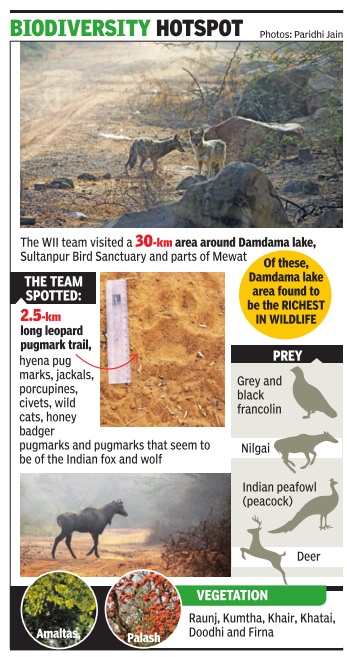
Haryana to allow houses on hillock next to Damdama Any structure on the hill will block flow of rainwater, thereby endangering the future of the water body Dipak Kumar Dash | TNN
Damdama (Gurgaon): Another lake in the Aravalis may soon be consigned to oblivion. If Surajkund and Badhkal lakes succumbed to mining activities in the Aravalis, Damdama, the last surviving water body in the region, may also go dry thanks to the government’s short-sighted policy that will soon facilitate construction in the area.
The revenue department in Gurgaon has almost completed the consolidation (Chakbandi) of plots on a hillock — Roj Ka Gujjar — spread over 5,744 acres adjacent to the lake. This will allow owners to construct houses on their plots. And any structure on the hillock, say environmentalists, will obstruct smooth flow of rainwater, the only source of replenishment, to the lake, almost 40 km from the national capital.
‘‘Any activity in the region will mean that the flow of rainwater to the lake will stop or would be adversely affected. Moreover, people will end up extracting groundwater, which is equally damaging,’’ said R P Balwan, former conservator of forest of southern circle (Gurgaon).
Originally, the hill was commonly owned by residents of 12 villages in the region. ‘‘But almost 90% of the land on the hill has already been sold to outsiders, mostly from Delhi. This had been happening since 1980s. The original owners have sold their shares, though those were not identified. After the consolidation, plots will be demarcated and given to the new individual owners. Those who have bought land are rich and influential people,’’ said a revenue department official.
However, he added that when the department was about to notify consolidation, a scam was detected and the process was put on hold. ‘‘We found that the total land sold was more than the actual area of Roj Ka Gujjar. An additional 631 acres had been sold. The regional commissioner has ordered us to halt the process of handing over of the plots,’’ he added.
The list of discrepancies doesn’t end there. The Ministry of Environment and Forest (MoEF) had written to Haryana government in December 1992 mentioning that all the areas notified under Punjab Land Preservation Act (PLPA) are forests and such areas cannot be used for non-forestry activities without prior permission from the ministry. Though Roj Ka Gujjar is covered under PLPA, its land is now up for consolidation.
Balwan said that construction of any dwelling unit, road or path, electricity poles has also been prohibited. Moreover, the hillock was also covered under Aravali plantation, which has been declared as deemed forest by the Supreme Court. ‘‘The revenue department should not have allowed the sale and purchase of common land since it was not demarcated or fragmented,’’ he added.
But, people who have bought land adjoining the half-dry waterbed of Damdama have started constructing boundary walls. ‘‘In the last few years, more people have bought land around the lake. Things would get worse when more people will occupy the hilltop,’’ cautions Bane Singh, a resident of Damdama village.
Sources said that the revenue department wants to ensure that the drains and streams, which carry rainwater to the lake, are not blocked. ‘‘We have included this in the consolidation scheme so that the natural water supply to the lake is not disturbed. Though consolidation would be finalised soon, land owners would have to get approval for anything they do on their land,’’ said a senior revenue department official.
Wildlife
2017: wildlife density in five districts
In the first survey of its kind on population density of wild animals in five districts of Haryana, the Wildlife Institute of India (WII) has found leopards occupy a 200 square km area in these parts of the Aravalis. And the terrain in Gurgaon and Faridabad districts happens to be their core area.
“Total area under leopard occupancy was estimated to be 200.9 square kilometres.Sites namely Gamroj (Bhondsi), Raipur (Raisina), Mangar, Gothda, Badhkal, Kotla Kansali, Nimatpur (Nayaan), Khol and Panchota have higher psi (population stability index) estimates,“ states the survey report, which was released by chief minister Manohar Lal Khattar and Union environment minister Harsh Vardhan.
“Out of five districts -Gurgaon, Faridabad, Mewat, Rewari and Mahendergarh -the occupancy of leopards is the highest in Gurgaon and Faridabad. Moreover, the core zone (highest used region by the leopard) is also in these two districts,“ said an official of WII who did not wish to be named.
Besides field sampling and analysis, WII used 12 camera traps to track the sightings of wild animals in the Aravalis. As many as seven sightings of leopards were reported in the camera traps within 30 days in October 2016. Moreover, sightings of 13 other species were recorded in the camera traps -seven of striped hyena, nine of golden jackal, 55 of nilgai, seven of palm civet, 14 of wild pig, 55 of rhesus macaque, 57 of peafowl and 12 of the Indian crested porcupine. The camera traps were put up in Bhondsi, Gamroj, Mangar, Bandhwari, Wazirabad, Gothda and Anangpur.
The survey found the jackal to be the highest-occurring carnivore species, followed by the hyena, and nilgai was found to be the highest occurring ungulate in the area. “Jackals are present in almost every grid with 92% occupancy ,“ the report states.
MD Sinha, conservator of forests (Gurgaon circle), said there has definitely been an increase in wildlife population, particularly that of leopards in the area. “There is an area of over 35,000 hectares around Gurgaon, which is very sensitive for wildlife.Seven sightings of big cats in 12 camera traps is a very good number,“ he told TOI.“Also, four successful leopard rescues have been conducted in the last six months by the forest department. There is an immediate need to protect the green cover and lay out a long-term wildlife management plan as wildlife is continuously increasing in the Aravalis,“ he added.
Asked if a wildlife census will be conducted in the Aravalis, Sinha said, “The department has already submitted a plan to conduct a comprehensive study and census of wildlife. We have already submitted a proposal to put radio collars on wild animals.“ The WII report also recommended an immediate end to mining activities in Haryana.
